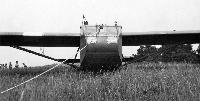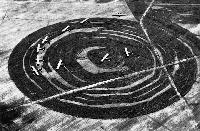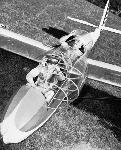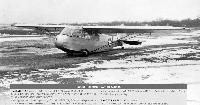Фотографии
-
"Just follow the rope!" View from the cockpit of a CG-4A in high tow above a C-47.
Самолёты на фотографии: Douglas DC-3 / C-47 Skytrain/С-53 Skytrooper / Dakota - США - 1935WACO CG-4A Hadrian - США - 1942
-
An early CG-4 stands ready for a training flight with tow line already attached to the fitting above the cockpit.
Самолёты на фотографии: WACO CG-4A Hadrian - США - 1942
-
Despite its ungainly looks, the CG-4A was well behaved and comparatively easy to fly. This meant relatively few training hours were necessary before the student was judged sufficiently competent.
Самолёты на фотографии: WACO CG-4A Hadrian - США - 1942
-
A pilot performing a rapid stopping manoeuvre during training by pitching the glider forward onto its nose skids, July 1943. The emergency exit doors have been removed for cooling in the hot summer weather and for rapid egress.
Самолёты на фотографии: WACO CG-4A Hadrian - США - 1942
-
An improvised 'bulls-eye' mowed into a field served as a spot landing aid for CG-4 student pilots.
Самолёты на фотографии: WACO CG-4A Hadrian - США - 1942
-
A TG-4 acts as the centrepiece for a War Bonds gala soon after the US entered the conflict. For a brief period, glider pilots were seen as warrior heroes!
Самолёты на фотографии: Laister-Kauffman LK-10 / TG-4 - США - 1941
-
A Schweizer TG-3 in civilian markings is hauled aloft by a winch, the parachute near the nose is used to lower the line gently once released. The TG-3 was an improved TG-2, more suitable for Army training.
Самолёты на фотографии: Schweizer SGS 2-12 / TG-3 - США - 1942
-
Two of the men most influential in the US Army Glider programme was Air Corps chief General 'Hap' Arnold (rear) and Major (soon Colonel) Fred Dent (front). They are trying out the Army’s first glider, a Schweizer TG-2 during September 1941 in New York.
Самолёты на фотографии: Schweizer SGS 2-8 / TG-2 - США - 1938
-
The US Army's first glider, a Schweizer TG-2, is assembled for flight after being removed from its trailer. A direct copy of a successful civilian competition design, it was contracted for and delivered in the span of three months
Самолёты на фотографии: Schweizer SGS 2-8 / TG-2 - США - 1938
-
Регистрационный номер: NX28386 Reputable American sailplane maker Hawley Bowlus wasn't as good a businessman. His XTG-12 did eventually fly, illustrated trials in the California desert, but it was too late and with too little evidence of production capacity.
Самолёты на фотографии: Bowlus TG-12 - США - 1942
-
The two-place Pratt, Read & Co LNE-1 was built for Navy and Marine Corps glider pilot training and featured unusual side-by-side seating. That programme folded in 1943 and the gliders were transferred to the Army as the TG-32, though they were simply stored.
Самолёты на фотографии: Pratt-Read LNE-1 / TG-32 - США - 1942
-
Регистрационный номер: NX34213 The XTG-5, the first three-seat glider trainer, at Aeronca's Ohio facility, ready to fly just days after the idea of converting its L-3 lightplane was suggested.
Самолёты на фотографии: Aeronca TG-5 - США - 1941
-
Few of the aircraft employed in the US combat glider programme could be considered elegant, and the TG-8 was farthest from such an accolade. Built by Piper, the type provided efficient training for tough business
Самолёты на фотографии: Piper TG-8 - США - 1941
Статьи
- Round-Out
- The Roundels File
- B.Norton - Ready for the Silent Assault /World war two/ (2)
- D.Nicolle - Fury over Palestine /Post-war conflict/ (2)
- D.Willis - Extended Family /Post-war combat/ (4)
- F.Mormillo - Wings and Rotors /History on the wing/
- G.Bussy - Frustrated Firebrand /Post-war combat/
- G.Cruz, R.Canamares - Iberian 'T-birds' /Air forces/ (2)
- N.Follett - Swift Australians /Between the wars/












